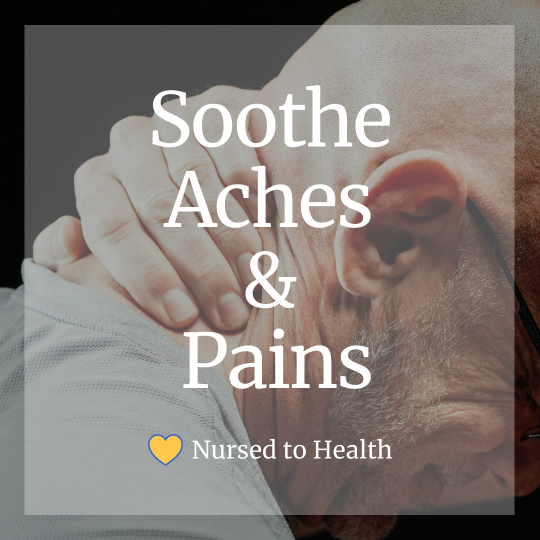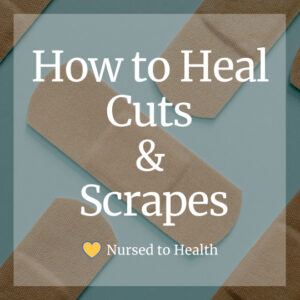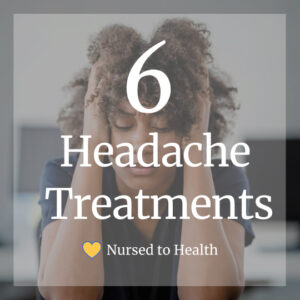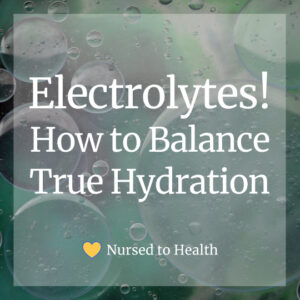Aches and Pains: How to Soothe in 11 Ways
Aches and pains are something we are all probably familiar with! “Oops I slept wrong, ouch my knee aches, oh I shouldn’t have done that,” and many more are commonly associated with some kind of body pain. What can we do when a minor ache or pain sneaks up on us? Aside from serious injuries, let’s chat about the every day ailments that we can manage at home. I have a collection of treatments here that are natural and also conventional. See your doctor if you have an ache or pain, especially severe, that does not resolve!
1. Magnesium Cream
This is a secret favorite of mine! Magnesium is a natural muscle relaxer, a wonderful calming mineral. We can absorb magnesium though the skin, even in an epsom salt bath, or with a cream. With this cream, the magnesium will get absorbed directly to the area that you apply it and also into the bloodstream. It works so well for achey muscles, and most of us are not getting enough magnesium on a daily basis anyway. You might notice your whole body relaxes after you apply it and may even sleep better. This particular one has very simple ingredients, is creamy and moisturizing, and it works in minutes: Magnesium Cream
2. Topical Analgesics – Lidocaine, Icy Hot, BioFreeze, Tiger Balm, Salonpas, Aspercreme
Pain creams. There are a variety of creams and gels that you rub on your skin on the area that hurts. What they do is numb that area and create a cooling/warming sensation that distracts the body from the actual pain. Some of them use menthol, camphor, or lidocaine as ingredients. It is a classic natural remedy that we still see very popular around today!
3. Heat & Cold Therapy
If your muscles are sore, stiff, or tight put some heat on there. Get a heating pad or heat compress, apply it to the painful area, and it will relax the muscles and allow the tissue to loosen up. On the other hand – if your knee is swollen, hot, or inflamed this is where the ice comes in. Ice is best for minor sprains or joint inflammation. Ice also numbs the area, relieving pain. Not sure which one to use? Try either or both.
4. Arnicare
This is a cream, gel, or ointment to be applied directly to the area. I actually first discovered Arnicare 15 years ago while desperately searching for a face acne treatment. It actually helped! Arnicare is useful in helping swelling, bruising, and muscle stiffness. It helps to heal bruises faster and relieves muscle pain. Arnica is an old homeopathic natural herb used for many years in home remedies. I like the cream version the best!
5. Turmeric
Welcome to the trend of turmeric! Turmeric is growing in popularity in its effectiveness in treating pain and inflammation. The active ingredient, curcumin, acts like an NSAID and blocks inflammation chemicals in the body. *Be careful with all supplements in that they are a completely unregulated industry. Don’t take mega doses of any supplements, see this example here of a lady with liver damage from high doses of turmeric. Turmeric toxicity
6. Massagers and Stretching
Have you used one of those massage gun things? Oh they are heavenly on a sore neck or back! Electric massage devices can really soothe cramps or muscle soreness, rubbing the ache out. There are also manual (non-electric) massagers that you can hold in your hand and massage out any cricks or knots yourself. Also, gently and carefully stretch the muscles in the affected area. This will bring oxygen into those cramped muscles and flush out the lactic acid causing the pain.
7. NSAIDs – Advil, Aleve, Aspirin + others
NSAID stands for Non-Steroidal Anti-Inflammatory Drug. NSAIDs are a popular gold-standard in treating all aches and pains, because they work well and are generally safe. They bring pain relief by blocking the inflammation chemicals in our body. Take as directed on the bottle or ask your doctor about a higher dose if needed. Be careful because heavy NSAID use can cause stomach bleeding and/or kidney damage and they can also raise blood pressure. Generic names are: ibuprofen, naproxen. Some prescription NSAIDs are: Meloxicam, Toradol, Diclofenac. There is also a topical cream NSAID called Voltaren Gel that can be applied directly to the area.
Why “Non-Steroidal, why not Steroids?” We will chat about steroids in another post.
8. Tylenol
We’ve all heard of Tylenol, or acetaminophen or Paracetamol. Tylenol is good for minor pain, we use it all the time in the hospital! It is our go-to medicine for mild pain rated on a scale of 1-3 (out of 10). Tylenol reduces pain signals and is more gentle on the body than NSAIDs. It is different because it does not reduce swelling/inflammation. Tylenol can be helpful for breakthrough pain, alternating with an NSAID when pain is relentless, and is a standard in treating headaches and fevers. The biggest caution for Tylenol is liver damage if you take too much, so be careful to take as directed!
9. Formula 303
This is a natural muscle relaxant herbal supplement. It contains magnesium to calm the muscles and also 2 other herbs to help with tension and relaxation. This is a gentle option that can help with mild muscle aches and also stress relief. As with all supplements and vitamins, be very careful because there is no oversight or regulation. Take as directed on the bottle. Link to Formula 303
10. Muscle Relaxers – Flexeril, Soma, Robaxin, Baclofen
Do you have a particular muscle issue, especially with muscle spasms, that is persistent? Your doctor may recommend prescription muscle relaxers. You can only get these medications by prescription. These medications block the nerves that supply the muscles and calm the nervous system. This is why they often make people sleepy or groggy. So be careful to rest and not drive if taking muscle relaxers. We see these prescribed in more conventional diagnoses vs. at home treatments. However, they are worth covering here in Aches and Pains because they are a valid approach in pain relief.
11. Are you hydrated?
Make sure you are properly hydrated to feed your muscles, your tissues, and all the precious cells working in your body. See my post on Dehydration here.
More topics to come! Opioid Medications and Severe Injuries





